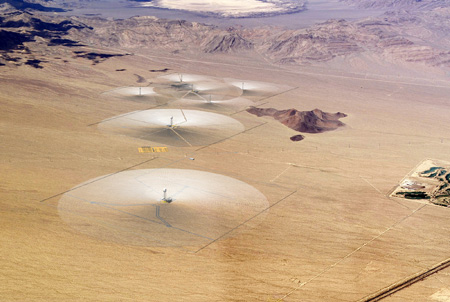The California solar power gold rush continued unhindered this week as the state’s Energy Commission unanimously voted in its fourth large scale solar thermal plant in as many weeks, as it heads towards a goal of nine plants approved before year’s end. This time around the Ivanpah Solar Electric Generating System project in the Mojave Desert was given thumbs up as a 370 megawatt plant noted for being among the first commercial solar thermal power plants permitted on federal public land in the United States.
The Ivanpah project is up for more than $1.37 billion in loan guarantees under the American Recovery and Reinvestment Act. Its developer, BrightSource Energy, believes that when the plant is fully constructed it will “nearly double the amount of solar thermal electricity produced in the United States today.” Specifics of Ivanpah call for development of three solar thermal power plants and shared facilities in the Mojave Desert west of Ivanpah Dry Lake and 4.5 miles southwest of Primm, Nevada. The project would be located on 3,582 acres of public land managed by the Bureau of Land Management, which must still sign off it as well.

This particular project proved more concerning than others to date with potential issues. It was stated by the energy commission that, even with mitigation measures, this facility will “have significant impacts on biological resources, land use, traffic and transportation, transmission systems engineering, and visual resources.” It has been the subject of on-site protests of late via those concerned about possible ecological impacts in the Mojave Desert.
It is said Ivanpah will be built “in three phases: one 120-MW phase and two 125-MW phases and is based on distributed power tower and heliostat mirror technology, in which heliostat (mirror) fields focus solar energy on tower receivers near the center of each heliostat array to generate steam-driven electricity.”
“This project presented us with significant environmental challenges,” said Energy Commissioner Jeffrey Byron, in a statement. “However, the applicant’s changes to the original proposal and the constructive input of a record number of participants mean the Ivanpah project will now produce renewable energy and provide needed economic activity to the region while minimizing the impact to the desert’s natural environment.”
Like what you are reading? Follow us on RSS, Twitter and Facebook to get green technology news updates throughout the day and chat with other green tech lovers.